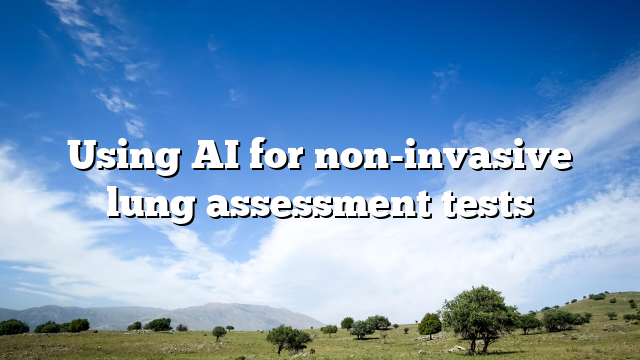Assessment of the lungs is essential for the diagnosis and treatment of respiratory illnesses such as asthma and chronic obstructive pulmonary disease (COPD). Conventional assessments of lung function, such as spirometry and body plethysmography, require patients to engage in intrusive and often painful forced breathing exercises. Nevertheless, recent developments in artificial intelligence (AI) have opened up new possibilities for non-invasive lung assessment testing. These techniques are able to offer evaluations of lung function that are both more accurate and more thorough.
The use of machine learning, a subfield of artificial intelligence that makes use of algorithms to study data and learn from it, is one of the most promising methods for doing non-invasive lung assessments using AI. Patterns that might aid in the diagnosis and treatment of respiratory disorders can be identified via the use of machine learning, which can examine complicated data sets from a variety of sources, such as medical pictures and physiological signals, among other types of data.
You might also like to read: Ultrasound-Guided Neuraxial Anesthesia for Vaginal Hysterectomy
Computed tomography (CT) and magnetic resonance imaging (MRI) are two examples of imaging methods that may be used in medicine to get precise information on the anatomy and function of the lungs. These photos may be analyzed by machine learning algorithms, which can then detect irregularities and forecast the evolution of illness. A recent study, for instance, employed machine learning to analyze CT pictures of COPD patients. The researchers were able to identify patterns of lung tissue loss that were connected with the severity of the illness as well as the prognosis.
Analysis of physiological data, such as breathing sounds, electrocardiogram (ECG), and oxygen saturation, is another potential way for doing non-invasive lung evaluation using artificial intelligence (AI). Wearable sensors have the capability of recording these signals, and machine learning algorithms can evaluate the data to identify irregularities and forecast the course of illness. For instance, a recent study employed machine learning to analyze breathing noises that were captured by a wearable sensor. The researchers were able to identify patterns that were connected with the degree to which COPD was present.
You might also like to read: Healthcare’s IT Inflection Points
Lung assessment tests that are driven by AI may provide numerous benefits over more conventional forms of lung function testing. To begin, they do not demand patients to undertake any invasive procedures and do not ask patients to engage in any forced breathing techniques, which may be difficult for patients who are suffering from respiratory disorders. The second advantage is that they are able to give more in-depth evaluations of lung function by evaluating data obtained from a variety of sources, such as medical pictures and physiological signals. Last but not least, they are able to offer evaluations of the patient’s lung function that are more accurate and individualized since they take the patient’s unique features into consideration.
In spite of this, there are a few obstacles that need to be overcome before AI-powered lung assessment tests can be made generally accessible. To begin, in order to train machine learning algorithms, big data sets are necessary, and the data sets themselves must be representative of the population that is being researched. Second, in order to assess the accuracy and reliability of machine learning algorithms, standard lung function tests need to be compared with the results of clinical studies. In conclusion, it is necessary to give serious consideration to the moral and legal repercussions that may result from using AI in medical diagnosis and treatment, especially in terms of protecting patient privacy and obtaining informed permission.
You might also like to read: Preventing Physician Burnout: How Mining EHR Data Can Help Improve Documentation Practices
In conclusion, non-invasive lung assessment tests that are driven by artificial intelligence have the potential to change the diagnosis and treatment of respiratory disorders by offering more accurate and complete evaluations of lung function. Algorithms that learn from machine data may examine medical imaging and physiological signals to look for patterns that might aid in the diagnosis and treatment of respiratory disorders. Nevertheless, before these tests can be made readily accessible to the general public, there are a number of obstacles that need to be overcome. These obstacles include the need for large representative data sets, validation studies, and careful consideration of the ethical and legal consequences. In general, the creation of lung assessment tests that are driven by artificial intelligence is a fascinating field of study that has the potential to enhance the quality of life for millions of individuals who suffer from respiratory disorders.

Darren Trumbler is a versatile content writer specializing in B2B technology, marketing strategies, and wellness. With a knack for breaking down complex topics into engaging, easy-to-understand narratives, Darren helps businesses communicate effectively with their audiences.
Over the years, Darren has crafted high-impact content for diverse industries, from tech startups to established enterprises, focusing on thought leadership articles, blog posts, and marketing collateral that drive results. Beyond his professional expertise, he is passionate about wellness and enjoys writing about strategies for achieving balance in work and life.
When he’s not creating compelling content, Darren can be found exploring the latest tech innovations, reading up on marketing trends, or advocating for a healthier lifestyle.
